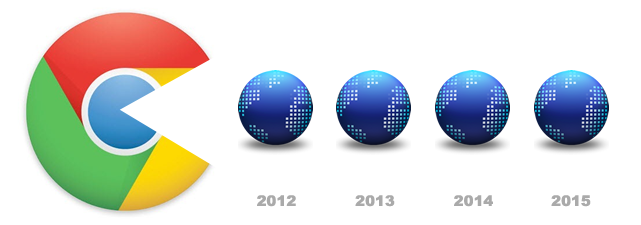Android and the eternal dying mobile browser
About 3 min reading time
Android Browser, one of the most important mobile browsers out there is an eternal dying piece of software. Android hasn’t evolved its default browser since 2011 and this is affecting HTML5 developers, including Cordova/PhoneGap apps, while Google Chrome is replacing it slowly.
Today Android 4.3 JellyBean update was released and after some testings I can confirm that the browser is still the same as the one with Android 4.0 launched on October 2011. No new APIs, no new support, same bugs and problems.
Just a quick reminder: Android Browser is the default browser in the OS and has no relationship with Chrome or Chromium (well, it’s using a WebKit engine as the base for current Chrome).
According to different sources, Android Browser is fighting the first place with Safari on iOS in mobile web market share. While numbers can differ depending on the source, it’s clear that it’s still part of the two most important browsers.
For example, Akamai Internet Observatory says that around 40% of the whole mobile browsing is done with Android Browser and only 6% with Google Chrome. On the other hand, StatCounter Global Stats says Android Browser is still 30% while Google Chrome only 3%.

Based on StatCounter and Akamai.IO, Android Browser is one of the most used browsers on mobile devices on July 2013
These stats don’t separate Android by OS version, but according to the official Android Dashboard 38% of the Android market share is still on Android 2.x. And the Android Browser on this version is still worst: no SVG, terrible performance and less API support.
What about Google Chrome #
Google Chrome for Android is leading the HTML5 ecosystem in terms of developer tools, compatibility, APIs and new CSS support. We are very happy with the Chrome team. However, Chrome is available for download only for Android 4.0+ and even on new devices it’s the default browser only on some specific devices. That’s the reason for not seeing Chrome as the main browser for Android users yet.

We know Android Browser will die eventually in the future, but the agony is taking too long so we need a solution in the meantime
How does a dying mobile browser affect us? #
- No remote debugging: this is a huge problem today
- Some specs are implemented with an older deprecated version, such as Network Information and HTML Media Capture
- No support for some APIs affecting the kind of apps/games we can develop for it, compared to Safari/Chrome/FF: Server-Sent events, Web Sockets, Web Workers, Rich HTML5 form controls, FileSystem, IndexedDB, Animation timing
- No hopes for advanced APIs for the future, such as WebGL, Web Audio, Web RTC or getUserMedia.
If you want to compare all the mobile browsers, check this table.
Stuck also for native apps #
Having to deal with this dying browser means also that we are stuck in terms of the WebView, the native control to create hybrid apps or show HTML content in a native Android app.Therefore, Apache Cordova (PhoneGap) developers have to use this dying engine even on the most modern Android device.
While the Chrome team has announced twice that Chrome Apps for Androids and a ChromeWebView may be available later, we don’t have a solution out there yet.
Compare it with other browsers #
In terms of compatibility, Android Browser is far way at this point. Using HTML5 Test, Android Browser 4.0-4.3 scores 297 while Chrome scores 410 and even IE10 on Windows Phone scores 320.

HTML5Test comparison between Android Browser, Chrome and IE10
Internet Explorer 10 for Windows Phone is better than Android Browser
I think we need a solution while Google Chrome gains market. Just waiting for the long agony doesn’t seem a good idea anymore. It’s talking much more time that we all expected.
What do you think?

 by Maximiliano Firtman
by Maximiliano Firtman